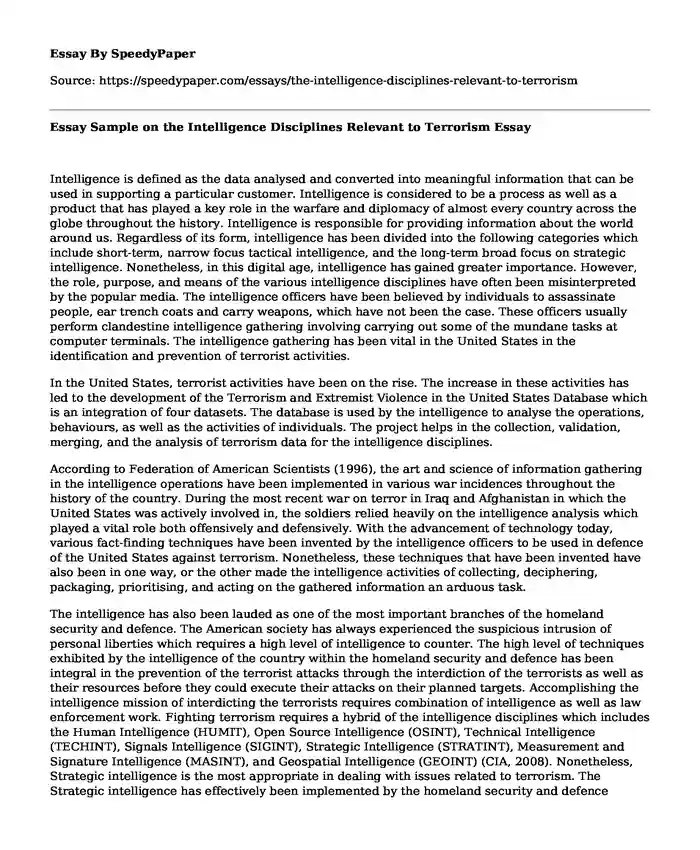
| Type of paper: | Critical thinking |
| Categories: | Intelligence services Terrorism |
| Pages: | 3 |
| Wordcount: | 652 words |
Intelligence is defined as the data analysed and converted into meaningful information that can be used in supporting a particular customer. Intelligence is considered to be a process as well as a product that has played a key role in the warfare and diplomacy of almost every country across the globe throughout the history. Intelligence is responsible for providing information about the world around us. Regardless of its form, intelligence has been divided into the following categories which include short-term, narrow focus tactical intelligence, and the long-term broad focus on strategic intelligence. Nonetheless, in this digital age, intelligence has gained greater importance. However, the role, purpose, and means of the various intelligence disciplines have often been misinterpreted by the popular media. The intelligence officers have been believed by individuals to assassinate people, ear trench coats and carry weapons, which have not been the case. These officers usually perform clandestine intelligence gathering involving carrying out some of the mundane tasks at computer terminals. The intelligence gathering has been vital in the United States in the identification and prevention of terrorist activities.
In the United States, terrorist activities have been on the rise. The increase in these activities has led to the development of the Terrorism and Extremist Violence in the United States Database which is an integration of four datasets. The database is used by the intelligence to analyse the operations, behaviours, as well as the activities of individuals. The project helps in the collection, validation, merging, and the analysis of terrorism data for the intelligence disciplines.
According to Federation of American Scientists (1996), the art and science of information gathering in the intelligence operations have been implemented in various war incidences throughout the history of the country. During the most recent war on terror in Iraq and Afghanistan in which the United States was actively involved in, the soldiers relied heavily on the intelligence analysis which played a vital role both offensively and defensively. With the advancement of technology today, various fact-finding techniques have been invented by the intelligence officers to be used in defence of the United States against terrorism. Nonetheless, these techniques that have been invented have also been in one way, or the other made the intelligence activities of collecting, deciphering, packaging, prioritising, and acting on the gathered information an arduous task.
The intelligence has also been lauded as one of the most important branches of the homeland security and defence. The American society has always experienced the suspicious intrusion of personal liberties which requires a high level of intelligence to counter. The high level of techniques exhibited by the intelligence of the country within the homeland security and defence has been integral in the prevention of the terrorist attacks through the interdiction of the terrorists as well as their resources before they could execute their attacks on their planned targets. Accomplishing the intelligence mission of interdicting the terrorists requires combination of intelligence as well as law enforcement work. Fighting terrorism requires a hybrid of the intelligence disciplines which includes the Human Intelligence (HUMIT), Open Source Intelligence (OSINT), Technical Intelligence (TECHINT), Signals Intelligence (SIGINT), Strategic Intelligence (STRATINT), Measurement and Signature Intelligence (MASINT), and Geospatial Intelligence (GEOINT) (CIA, 2008). Nonetheless, Strategic intelligence is the most appropriate in dealing with issues related to terrorism. The Strategic intelligence has effectively been implemented by the homeland security and defence department in the United States of America to ensure that the country is safe from the terrorists and their activities (Heidenrich, 2008).
References
CIA. (2008). Abbreviations and acronyms. Retrieved from CIA: https://www.cia.gov/library/center-for-the-study-of-intelligence/csi-publications/books-and-monographs/directors-of-central-intelligence-as-leaders-of-the-u-s-intelligence-community/glossary.htm
Federation of American Scientists (1996). The evolution of the U.S. intelligence community: An historical overview. Retrieved from http://www.fas.org/irp/offdocs/int022.html
Heidenrich, J.G. (2008). The state of strategic intelligence: The intelligence community's neglect of strategic intelligence. Retrieved https://www.cia.gov/library/center-for-the-study-of-intelligence/csi-publications/csi-studies/studies/vol51no2/the-state-of-strategic-intelligence.html
Cite this page
Essay Sample on the Intelligence Disciplines Relevant to Terrorism. (2022, Jun 08). Retrieved from https://speedypaper.net/essays/the-intelligence-disciplines-relevant-to-terrorism
Request Removal
If you are the original author of this essay and no longer wish to have it published on the SpeedyPaper website, please click below to request its removal:
- Ethical Problems of Finance - Free Essay for You
- Learning Through Play - Child Development Essay Example
- MATLAB Essay Example
- Free Essay Example in HRM: Hiring Mistakes
- Pregnancy in Workplace - Free Essay in Human Resource Management
- Film Review: My Sister's Keeper - Free Essay
- Essay Sample on Higher Education in America
Popular categories




